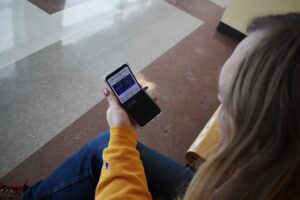Last month, when I found myself in need of a second phone for the sake of my own sanity, I dreaded buying another iPhone. My opinion from my column “iThink we’ve hit a wall” still stood. There was no way I was paying anywhere from $500-$1,100 for the same old, same old.
What I wanted was a foldable phone. Something that could either expand to a large canvas so I could get things done or shrink away so I could almost lose it in my pocket. But paying upwards of $1,000 for the burgeoning Samsung Galaxy Z class of smart phones was a tough pill to swallow.
That is until I caught a glimpse of the plentiful used market. I was incredibly skeptical going down this path because durability is still a big question mark. But at such an enticing price — a less than one-year-old Galaxy Z Flip 3 for $250, which is one fourth of its original cost — and considering the fact that 64% of our readership surveyed said they wouldn’t own a folding phone, I was willing to test the waters so you didn’t have to.
The main question I got asked during my first month of ownership — right after, “Can I flip it?” — was about its durability. I was worried about a loose or grinding hinge, bubbles in the display crease, scratches on the inside display’s ultra thin glass and any other unthinkable problem that could come from what I thought was such a fragile mechanism.

I’m happy to report that this feels just like new. Samsung confirmed the age of my Flip, and between my 550 flips within my month of ownership, which I can only assume would be higher if this were my primary phone, and the other 11 months of use before myself, I’m shocked and thrilled with the condition.
The next most common ask was about its usefulness. This has a bit more of a complicated answer. Half of the Flip’s usefulness to me is the size it reduces to in a pocket. The other half gets me in glanceability or tripoding. Being its own stand lets me keep apps open that auto refresh so I can always see new stuff and act on it quickly.
I also love taking video calls on it. I don’t have to hold it up, find something to prop it on or compromise with a landscape call to take advantage of a Popsocket stand. Samsung also added some nifty tricks into the OS to make the 90-degree mode more useful too.
It also just handles everyday phone stuff really well. The screen is vivid with a high refresh rate, and it’s just big enough to still manage with one hand. The battery is shockingly good for its unique design, lasting me two days with moderate usage. Phone calls were crystal clear, blowing my iPhone out of the water on the same network. The fingerprint reader was blazing fast, and I was happy they took a page out of Apple’s book and added a “raise to wake” feature. I won’t bore you with the specs of last year’s model because there are more technical publications that could pick those apart better than I ever could, but it’s still plenty fast for emails, video calls and light social media.
The only downfalls came from Android and the cameras, unfortunately. The OS really feels like it’s holding the phone back. There were so many quirks, like eSIM not working with my carrier due to what I was told was a fault with Android that would be fixed in an update on a date that came and went with nothing.
My notifications just disappeared when I tapped on them instead of opening the app or showing me the content. The OS switched between being too aggressive with background task management so that I didn’t get notifications, or not doing enough about a background task so that it killed my battery while cooking the phone.
These cameras, while serviceable, are just not as good as other flagships. Photos look over processed and too colorful to the point of appearing animated at times, and detail quickly disappears in low lighting. However, being able to use the rear shooters as a selfie camera, courtesy of the cover display, and the wide-angle option for the true front facing shooter are nice additions that help bridge the faults.
This experiment was eye opening. As a devout Apple user, it feels weird to say how much I ended up loving it. If the Z series of phone somehow ran iOS, I’d use a foldable for everything. For now, I’m more than happy to keep it as a work phone, and I can honestly recommend anyone looking for a budget Android phone, or some variety from the same Apple slabs, to give a foldable phone a chance.
